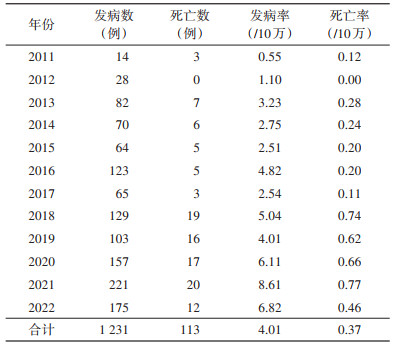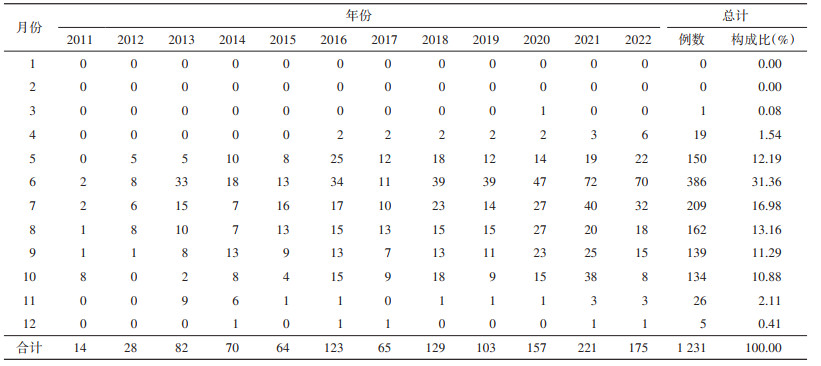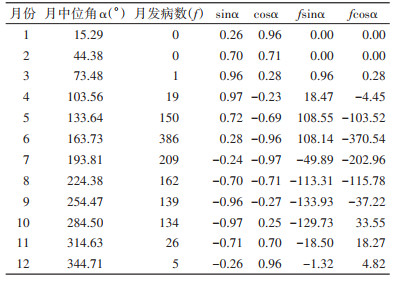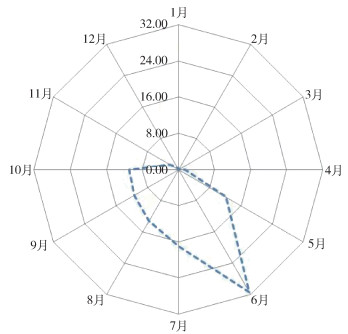扩展功能
文章信息
- 孙琦, 张国英, 高永伟
- SUN Qi, ZHANG Guo-ying, GAO Yong-wei
- 运用集中度和圆形分布法分析山东省威海市发热伴血小板减少综合征的季节性特征
- Seasonal characteristics of severe fever with thrombocytopenia syndrome analyzed with concentration ratio and circular distribution method in Weihai, Shandong Province, China
- 中国媒介生物学及控制杂志, 2023, 34(6): 794-798
- Chin J Vector Biol & Control, 2023, 34(6): 794-798
- 10.11853/j.issn.1003.8280.2023.06.016
-
文章历史
- 收稿日期: 2023-04-25
2 威海市环翠区动物疫病预防控制中心, 山东 威海 264200
2 Huancui District Center for Animal Disease Prevention and Control of Weihai, Weihai, Shandong 264200, China
发热伴血小板减少综合征(severe fever with thrombocytopenia syndrome,SFTS)是近年来我国新发现的自然疫源性传染病,主要分布在我国中东部地区的山区丘陵地带,山东省是SFTS重要的疫区[1]。在美国、日本、韩国也有SFTS的报道[2-4],该病的病原体大别班达病毒(Bandavirus dabieense)又称发热伴血小板减少综合征病毒(Severe fever with thrombocytopenia syndrome virus,SFTSV),属于布尼亚病毒目(Bunyavirales)白蛉纤细病毒科(Phenuiviridae)班达病毒属(Bandavirus)[5]。该病毒既可通过蜱叮咬传染传播,也可通过接触病人的血液和分泌物传播 [6]。动物血清学调查发现山东省威海市文登区犬和羊的SFTSV特异性总抗体较高 [7]。该病病死率高,严重威胁山区丘陵农民群众的健康和生命。本文运用集中度和圆形分布法分析山东省威海市自2011年首次报告SFTS病例以来,12年间该病的发病季节性特征,为准确判断SFTS在本地区的流行期,并采取及时有效的预防控制措施提供科学依据。
1 材料与方法 1.1 资料来源对中国疾病预防控制信息系统传染病报告信息管理系统中报告的实验室确诊SFTS病例进行筛选分类,地区选择山东省威海市,时间选择为报告发病日期,起止日期为2011年1月1日-2022年12月31日,状态为已审核,各年病例数据按照月份归类汇总。人口资料来源于山东省威海市统计局统计年鉴。
1.2 方法 1.2.1 集中度法[8-9]集中度计算公式M=




通过三角函数将具有周期性变化的资料转换成线性数据,以1年365 d计将发病时间转换为角度,全年为360°,1 d相当于0.986 3°(360/365),用平均角α描述圆形分布资料的集中程度。方法是将12个月每个月中值作为组中值并转换为月中位角αi(月中值×0.986 3°)即1月的角度α1=15.29°,2月的角度α2=44.38°,以此类推,再计算余弦值cosαi及正弦值sinαi,根据公式计算平均角α。X=Σficosαi/n,Y=Σfisinαi/n,r=




使用Excel 2007软件,录入整理2011-2022年SFTS病例数据,利用集中度、圆形分布法及雷氏检验分析发病季节性特征,使用SPSS 26.0软件进行统计分析,发病趋势使用χ2趋势检验,P < 0.05为差异有统计学意义。
2 结果 2.1 SFTS流行概况2011-2022年威海市累计报告SFTS病例1 231例,死亡113例,年均报告发病率4.01/10万,年均死亡率0.37/10万。其中2011年报告发病率最低(0.55/10万),2021年报告发病率最高(8.61/10万),发病率呈整体上升趋势(χ2=36.501,P < 0.001)。见表 1。

|
按照公历法划分(四季为:3-5月春季;6-8月夏季;9-11月秋季;12-2月冬季)发病时间主要分布在夏季,病例占61.49%(757/1 231),春季占13.81%(170/1 231),秋季占24.29%(299/1 231),冬季占0.41%(5/1 231)(表 2)。根据集中度的计算公式,山东省威海市SFTS发病Rx=-0.014,Ry=-0.66,M=0.66,M值在0.5~0.7,发病有较强的季节性。

|
山东省威海市2011-2022年SFTS月发病数、月中位角αi及相应的三角函数结果见表 3。根据圆形分布法公式计算得知:X=-0.632,Y=-0.171,r=0.654,α=195.15°,经雷氏检验,平均角α差异有统计学意义(Z=527.144,P < 0.001),圆形角存在,对应的天数为197.86 d,平均角标准差S=52.76°,流行高峰期对应的天数为144.37~251.44 d,即SFTS的平均发病日期为7月17日,流行期为5月25日-9月9日。高峰期持续时间约为3个半月,各月发病构成比雷达图见图 1。

|

|
| 图 1 山东省威海市2011-2022年发热伴血小板减少综合征月发病构成比雷达图 Figure 1 The radar chart of monthly incidence constituent ratio of severe fever with thrombocytopenia syndrome in Weihai, Shandong Province, 2011-2022 |
| |
为更好地了解山东省威海市SFTS发病的季节性分布特征,本次研究采用了集中度和圆形分布法进行分析。结果显示,山东省威海市的高峰日比内陆低纬度地区河南省信阳市[14]及安徽省中部主要疫区[6, 15]的SFTS发病高峰日即6月19日和6月21日延迟近1个月。高峰期比信阳市的4月27日-8月25日(121 d)及安徽省的4月15日-8月27日(135 d)晚1个月,短13~27 d。这一结果可能与山东省威海市的地理位置及气候类型有关。威海市位于山东半岛最东端,北纬36°41΄~37°35΄,四季分明,季风进退明显,降水量季节性分布较强,主要集中在5-9月,其中6-7月最多[16]。山东省威海市的SFTS发病高峰时间因地理位置因素与内陆暖温带与亚热带过渡区的部分疫区有所不同。
季节性因素影响SFTS发病的主要原因有:(1)SFTS的传播媒介蜱虫,其消长趋势受温度、湿度、风力等季节性因素影响明显。Kaizer等[17]研究显示,蜱幼虫大约在13 ℃停止活动,< 9.6 ℃时终止一切活动。研究显示,风力的增大与蜱虫的数量呈负相关,也与SFTS发病呈负相关[18]。这与威海市冬季SFTS发病较少相符。(2)丘陵山区的植被覆盖率受季节影响,夏秋季节植被覆盖率较冬春季节高。而SFTS高发地区,灌木、森林以及农田地区的植被覆盖率每上升10%,SFTS发病率分别提高51%、51%和90%[19]。这与威海市夏秋季节SFTS发病率较高相符。(3)重点人群暴露程度受季节因素影响。夏秋季节,重点人群在田间、野外活动频繁。蜱虫叮咬部位主要集中在头皮、耳朵、颈部,其次是躯干和四肢[19],而这些部位皮肤也因夏秋季节温度的升高而暴露面积更大,暴露时间更长。
综上所述,山东省威海市SFTS发病季节性较强,年发病率呈整体上升趋势,防控形势严峻。2011、2012年报告病例数较少,可能与SFTS发病初期当地医疗卫生机构对该病的认识不足有关,随着医务人员对该病的诊断救治水平逐渐提升,SFTS的病例报告数也呈上升趋势。威海市2011-2022年SFTS发病高峰期为5月25日-9月9日,应在此之前做好针对性的预防工作,提高重点人群的SFTS发病症状知晓率及防蜱虫叮咬意识,发现该病相关症状要及时就医。户外活动预防游离蜱叮咬。对易携带寄生蜱的家禽家畜做好驱蜱、灭蜱等工作[6]。加强各级医疗机构对SFTS的诊断和治疗能力的提升,做到早发现、早诊断、早治疗。同时疾控机构和动物疫病预防控制机构要加强联防联控,对SFTS做好实时监测,及时发现和处置聚集性病例和暴发疫情,防止疫情扩散。
利益冲突 无
| [1] |
段青, 逄博, 张晓梅, 等. 2011-2020年山东省发热伴血小板减少综合征流行特征及空间聚集性[J]. 中华疾病控制杂志, 2022, 26(7): 790-797. Duan Q, Pang B, Zhang XM, et al. Epidemiological characteristics and spatial aggregation of severe fever with thrombocytopenia syndrome in Shandong province from 2011 to 2020[J]. Chin J Dis Control Prev, 2022, 26(7): 790-797. DOI:10.16462/j.cnki.zhjbkz.2022.07.008 |
| [2] |
McMullan LK, Folk SM, Kelly AJ, et al. A new Phlebovirus associated with severe febrile illness in Missouri[J]. N Engl J Med, 2012, 367(9): 834-841. DOI:10.1056/NEJMoa1203378 |
| [3] |
Yokomizo K, Tomozane M, Sano C, et al. Clinical presentation and mortality of severe fever with thrombocytopenia syndrome in Japan: A systematic review of case reports[J]. Int J Environ Res Public Health, 2022, 19(4): 2271. DOI:10.3390/ijerph19042271 |
| [4] |
Kim MC, Chong YP, Lee SO, et al. Differentiation of severe fever with thrombocytopenia syndrome from scrub typhus[J]. Clin Infect Dis, 2018, 66(10): 1621-1624. DOI:10.1093/cid/cix1119 |
| [5] |
胡耕, 姜法春, 董礼艳, 等. 山东省青岛市5种蜱携带的优势微生物种群鉴定分析[J]. 疾病监测, 2023, 38(3): 264-269. Hu G, Jiang FC, Dong LY, et al. Identification of predominant microbial populations carried by five species of ticks in Qingdao, Shandong[J]. Dis Surveill, 2023, 38(3): 264-269. DOI:10.3784/jbjc.202301310014 |
| [6] |
曹琛, 吴家兵, 曹明华, 等. 安徽省2011-2015年发热伴血小板减少综合征流行特征分析[J]. 中华疾病控制杂志, 2016, 20(8): 792-795. Cao C, Wu JB, Cao MH, et al. Epidemiological analysis on severe fever with thrombocytopenia syndrome in Anhui province, 2011-2015[J]. Chin J Dis Control Prev, 2016, 20(8): 792-795. DOI:10.16462/j.cnki.zhjbkz.2016.08.010 |
| [7] |
姜晓林, 陈德颖, 吕涛, 等. 山东省威海市文登区3例发热伴血小板减少综合征死亡病例危险因素调查[J]. 中国媒介生物学及控制杂志, 2019, 30(6): 603-606. Jiang XL, Chen DY, Lyu T, et al. An investigation of risk factors for death in three patients with severe fever with thrombocytopenia syndrome in Wendeng district, Weihai, Shandong province, China[J]. Chin J Vector Biol Control, 2019, 30(6): 603-606. DOI:10.11853/j.issn.1003.8280.2019.06.002 |
| [8] |
金丕焕, 陈峰. 医用统计方法[M]. 3版. 上海: 复旦大学出版社, 2009: 327-333. Jin PH, Chen F. Public health preventive medicine[M]. 3rd ed. Shanghai: Fudan University Press, 2009: 327-333. |
| [9] |
陈永明, 康东梅, 闫萍, 等. 河北省鼠疫自然疫源地1990-2020年小型鼠监测结果分析[J]. 中国媒介生物学及控制杂志, 2022, 33(1): 89-93. Chen YM, Kang DM, Yan P, et al. An analysis of surveillance results for small rodents in natural plague foci of Hebei province, China, 1990-2020[J]. Chin J Vector Biol Control, 2022, 33(1): 89-93. DOI:10.11853/j.issn.1003.8280.2022.01.016 |
| [10] |
李炳辉, 朱海龙, 马小芳, 等. 基于集中度和圆形分布法分析山东省青岛市2017-2020年媒介蚊虫季节性特征[J]. 中国媒介生物学及控制杂志, 2022, 33(2): 230-233, 238. Li BH, Zhu HL, Ma XF, et al. Analysis of seasonal characteristics of mosquito vectors in Qingdao city of Shandong province during 2017 and 2020 by the concentration and circular distribution method[J]. Chin J Vector Biol Control, 2022, 33(2): 230-233, 238. DOI:10.11853/j.issn.1003.8280.2022.02.012 |
| [11] |
王庆昌, 李欣. 圆形分布分析的Excel实现[J]. 中国卫生统计, 2006, 23(5): 448-449. Wang QC, Li X. Excel implementation of circular distribution analysis[J]. Chin J Health Stat, 2006, 23(5): 448-449. DOI:10.3969/j.issn.1002-3674.2006.05.022 |
| [12] |
贾逸林, 徐晶, 徐红梅, 等. 2013-2021年上海市浦东新区聚集性发热疫情季节性和病原学特征分析[J]. 公共卫生与预防医学, 2023, 34(2): 56-59. Jia YL, Xu J, Xu HM, et al. Seasonal characteristics and etiologic features of the cluster of fever in Pudong New Area of Shanghai in 2013-2021[J]. J Public Health Prev Med, 2023, 34(2): 56-59. DOI:10.3969/j.issn.1006-2483.2023.02.012 |
| [13] |
董欢欢, 刘兴荣. 基于集中度和圆形分布法分析甘肃省人间布氏菌病季节性特征[J]. 中华疾病控制杂志, 2022, 26(2): 227-231. Dong HH, Liu XR. Analysis of seasonal characteristics of human brucellosis in Gansu province based on the concentration and circular distribution method[J]. Chin J Dis Control Prev, 2022, 26(2): 227-231. DOI:10.16462/j.cnki.zhjbkz.2022.02.018 |
| [14] |
尤爱国, 杨建华, 胡艳, 等. 信阳市发热伴血小板减少综合征发病季节性特征研究[J]. 现代预防医学, 2016, 43(15): 2689-2691, 2699. You AG, Yang JH, Hu Y, et al. Seasonal characteristics of fever, thrombocytopenia and leukopenia syndrome, Xinyang city[J]. Mod Prev Med, 2016, 43(15): 2689-2691, 2699. |
| [15] |
刘伯熙, 龚磊, 宋丹丹, 等. 应用集中度和圆形分布法分析安徽省2011-2017年发热伴血小板减少综合征的季节分布[J]. 中华实验和临床病毒学杂志, 2020, 34(3): 252-255. Liu BX, Gong L, Song DD, et al. Using concentration ratio and circular distribution method to analyze seasonal characteristics of severe fever with thrombocytopenia syndrome in Anhui province, 2011-2017[J]. Chin J Exp Clin Virol, 2020, 34(3): 252-255. DOI:10.3760/cma.j.cn112866-20200322-00084 |
| [16] |
宋华丽, 方娇慧. 1981-2015年威海市气候变化特征分析[J]. 中国人口·资源与环境, 2017, 27(增刊2): 204-207. Liu BX, Gong L, Song DD, et al. An analysis on the variation characteristics of climate in Weihai during 1981-2015[J]. China Popul Resour Environ, 2017, 27(Suppl 2): 204-207. |
| [17] |
Kaizer AM, Foré SA, Kim HJ, et al. Modeling the biotic and abiotic factors that describe the number of active off-host Amblyomma americanum larvae[J]. J Vector Ecol, 2015, 40(1): 1-10. DOI:10.1111/jvec.12126 |
| [18] |
Li S, Heyman P, Cochez C, et al. A multi-level analysis of the relationship between environmental factors and questing Ixodes ricinus dynamics in Belgium[J]. Parasit Vectors, 2012, 5(1): 149. DOI:10.1186/1756-3305-5-149 |
| [19] |
詹思延. 流行病学研究实例[M]. 第五卷. 北京: 人民卫生出版社, 2021: 18-19. Zhan SY. Examples of epidemiological studies[M]. Volume 5. Beijing: People's Medical Press, 2021: 18-19. |
 2023, Vol. 34
2023, Vol. 34


